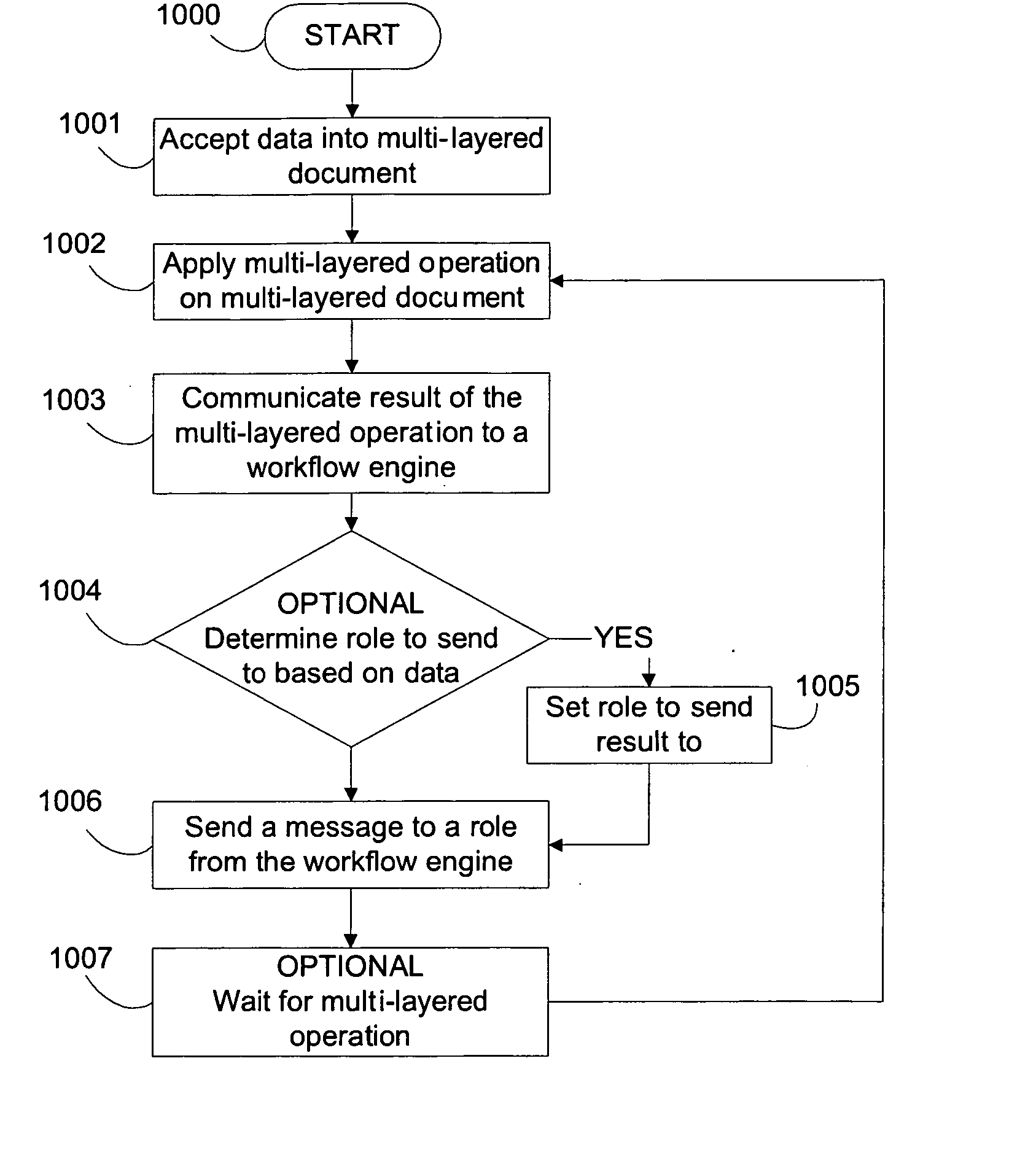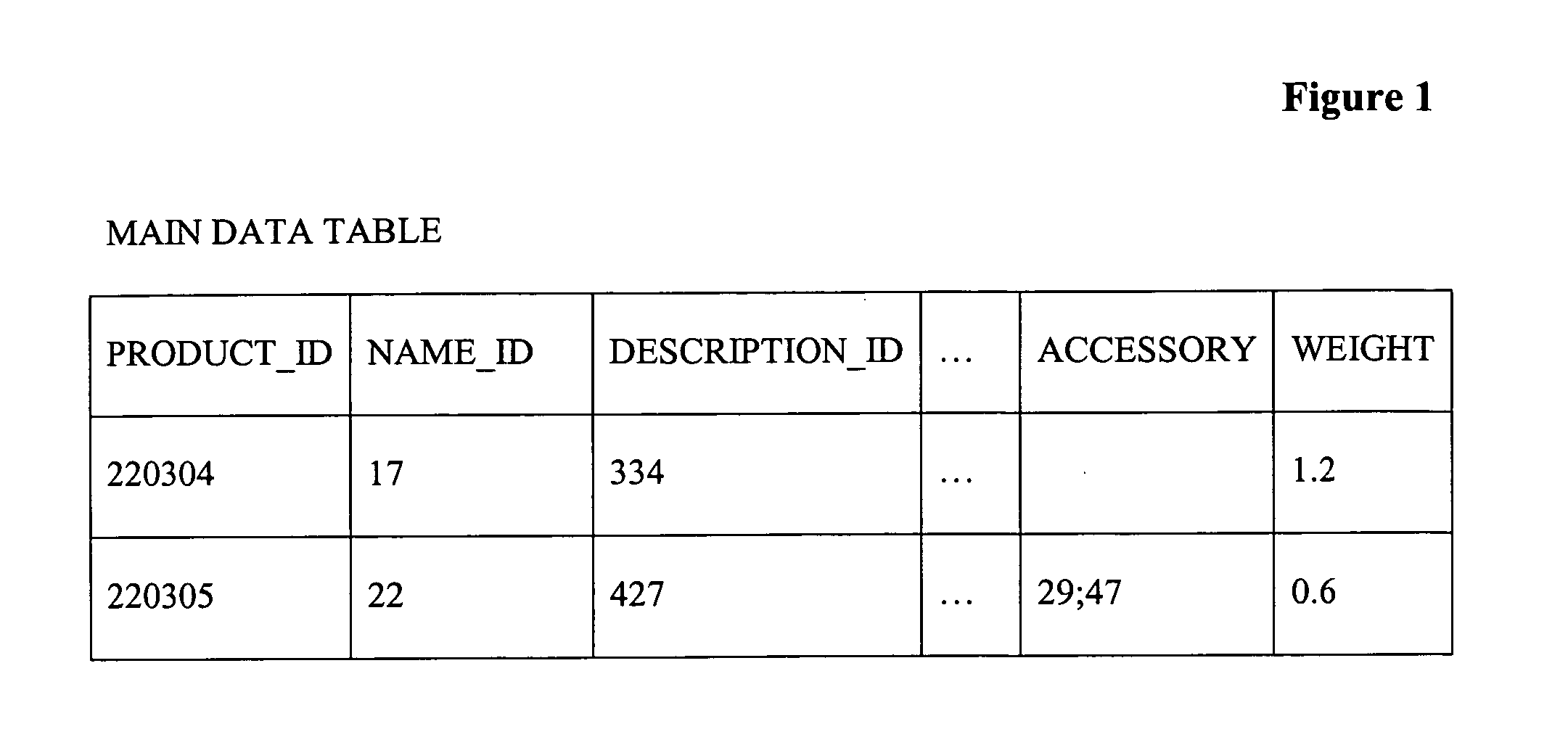[0009] Embodiments of the invention enable methods for enforcing group oriented workflow requirements for multi-layered documents. The
system provides methods for pushing or pulling data within the multi-layered
data set to a group of workers fulfilling a “role”. By using role based tasking, personnel changes based on substitution rules allow for temporary absences, including illness or vacation. A group performs multi-layered operations on the multi-layered
data set and the results dictate the flow of tasks that occur on a document. The multi-layered documents created and maintained by the
system minimize repeated data using multi-layered inheritance to ensure the highest possible
data integrity when targeting a publication at multiple audiences. The word “audience” for the purposes of this specification means a group of document consumers such as people or computers that are associated with a language, country, region, regulation or culture or any other
user defined division. Audience specific data in a multi-layered document therefore is data targeted at a specific audience. Sophisticated workflow enabled multi-layered data testing and validation tasks ensures that only properly formed data that meets the publication requirements ends up in the document. For example, multi-layered testing for fields having a value or Null value at a certain inheritance level within a multi-layered document allows for a workflow task to be executed based on the result of the test. Multi-layered validation or conditional branching validation using multi-layered data also allows for workflow branching.
Layout and publication multi-layered operations also enable workflow branching. When a publication is changed and requires maintenance, use of a defined workflow for updating the publication ensures consistency in each publication. External events such as deadlines may also that trigger workflow tasks. Embodiments of the invention also comprise performance
metrics for monitoring and benchmarking publication processes. This enables
repeatability and refinement of the publication process allowing for better estimates to be made in the future. Enforcing group oriented workflow for multi-layered documents also reduces cycle times for publication.
[0010] As utilized in the context of this disclosure, “fields” are associated with all records of the main data table, i.e., all records in the main data table comprise the same fields. “Attributes” are quantities that are associated with subsets of the main data table, i.e., specific to a given category which is a field in the main data table. Attributes do not reside in the main data table. Therefore, based on the value of a category field or other any other fields of the main data table, attributes may be associated with a subset of the records of the main data table. An “audience” may be thought of as a third dimension added on top of the main data table and attribute tables so that audiences that comprise different languages, regions, regulatory zones, or any other
subdivision based on any quantity may be used to form a hierarchy upon which to find data for fields or attributes that are not found on a given audience level in the
database. Audiences can be as complex as required to support the number of targets and number of languages, regions, religions, cultures or any other division conceivable. An audience hierarchy may be formed from the viewpoint of a given audience to take
advantage of the entries of most of the other fields of another audience, so that multiple audiences that are similar may be readily supported. For example, to support a catalog targeting the United Kingdom, the word “colour” in a field or attribute would simply need to have the word “color” replaced in order to support the same catalog targeted at the United States. By making one audience inherit from another, any entries not found in one audience are automatically obtained from another audience. This increases the integrity of the data and allows for one edit to alter the output for as many audiences as use a piece of data. “Lookup tables” are used in order to place a text object for example in one place in the
database and which are referenced by a smaller quantity, i.e., a reference identifier or key into the
lookup table. Lookup tables save large amounts of space and provide benefits with regards to
data integrity since a change of a value in a
lookup table may be made once instead of in a million records for example.
[0013] When publishing a document for multiple audiences in
multiple media types it is desirable, although not required, to subdivide the information in a main data table into manageable blocks of information. One or more embodiments of the invention define families of
data records that indirectly subdivide a main data table into a subset of data that is generally based on an existing taxonomy in the main data table, for example the “category” field of the
data records. A family is a subset of main table product records that are related by one or more common fields and / or attributes having the same value, and that may also have additional fields of family data, such as an image, a logo, a
paragraph of descriptive text, bullets of specifications, and so on. In one or more embodiments of the invention, attributes correspond to fields of information that apply only to some rather than all of the main table records as previously explained. For example,
voltage may be an attribute that applies to motors but not to gears. Fields are in the main data table, attributes are not. Families are defined outside of the main data table and therefore indirectly subdivide the main data table. Families are stored in a family table and may be hierarchical related. Families enable
master data to be efficiently published not only to paper, but also to non-paper media such as the Web in a manner that preserves the presentation and organization seen in printed catalogs, with the added benefit of fast, efficient product search.
[0015]
Quality assurance may be performed by the personnel performing
data entry or by another group of workers. Multi-layered testing operations comprise checking
layers across the desired publication for Null values and ensuring the data exists for the desired audiences in a visually appealing manner for all desired media types that the document will published. By enforcing validation early on, a
quality assurance group can concentrate on other tasks such as ensuring that data exists and that the publication looks good. This eliminates “throw it over the wall” type
quality assurance since the system is enforcing rules automatically. Subdividing the publication process into
family based tasks also allows for more granular control of the process and allows managers to concentrate on families that are incomplete or need special attention.
[0016] During testing or after the testing of the document is complete, laying out the document and
fine tuning the
layout occurs. Use of
WYSIWYG family tables allows for quick adjustment of each family view. This step may comprise multiple sub-tasks that are performed sequentially, concurrently or in a round-robin order with respect to members of a group. Laying out data may involve switching between target audiences to visually determine if the data associated with another audience fits the
layout defined for a given audience. This step may also be performed by a group separate from the
layout group.
[0017] Output to a
media type is performed by publishing the families associated with a multi-layered document for a desired audience. Publishing selected families in a given sequence can be used to further specify the generation of the document on a document by document basis. The laying out and publishing processes generate parameters that are fed into desktop publishing programs so that the
metadata related to the
look and feel of the finished document is stored in an embodiment of the invention as opposed to each desktop publishing program. This allows for independence of platform and
media type.
 Login to View More
Login to View More  Login to View More
Login to View More 


